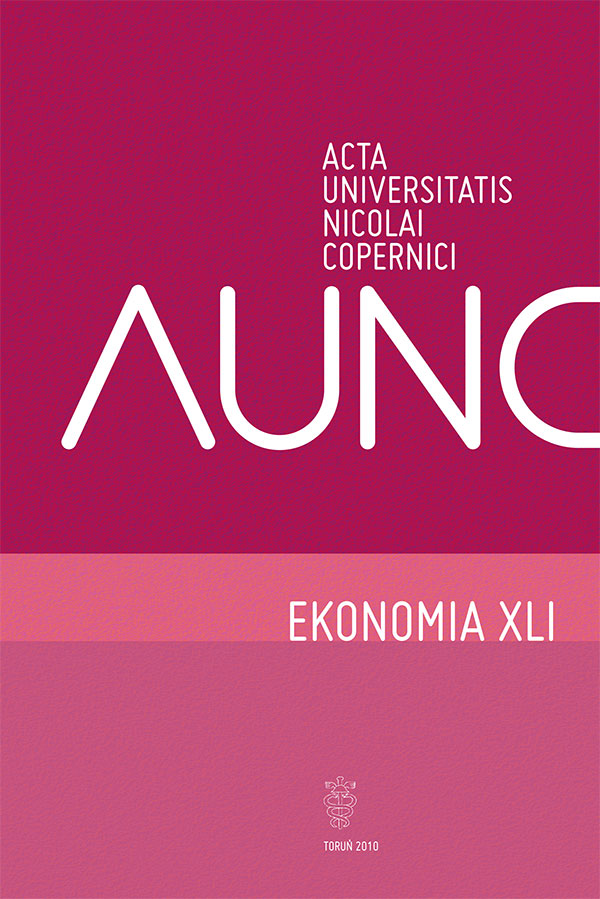Accumulative prediction error as a method of model selection
DOI:
https://doi.org/10.12775/AUNC_ECON.2010.003Keywords
model selection, meta-selection, information criteria, accumulative prediction errorAbstract
The purpose of the paper is to present and apply the accumulative onestep- ahead prediction error (APE) not only as a method (strategy) of model selection, but also as a tool of model selection strategy (meta-selection). The APE method is compared with the information approach to model selection (AIC and BIC information criteria), supported by empirical examples. Obtained results indicated that the APE method may be of considerable practical importance.
References
Aitchison J., Dunsmore I. R. (1975), Statistical Prediction Analysis, Cambridge University Press, Cambridge.
Akaike H. (1973), Information Theory and an Extension of the Maximum Likelihood Principle, [w:] Petrov B. N., Csaki F., Second International Symposium on Information Theory, Akademia Kiado, Budapest.
Burnham K. P., Anderson D. R. (2002), Model Selection and Multimodel Inference, Springer.
Christiano L. J., Eichenbaum M. (1990), Unit Roots in Real GNP: Do We Know and Do We Care?, „Carnegie-Rochester Conference Series on Public Policy”, nr 32, 7–61.
Clarke B. (2001), Combining Model Selection Procedures for Online Prediction, „Sahkhya: The Indian Journal of Statistics”, 63, seria A, 229–249.
Dawid A. P. (1984), Statistical Theory: the Prequential Approach, „Journal of Royal Statistical Society Series B”, 147, 278–292.
De Luna X., Skouras K. (2003), Choosing a Model Selection Strategy, „Scandinavian Journal of Statistics”, 30, 113–128.
Diebold F. X., Senhadji A. (1996), Deterministic vs. Stochastic Trend in U.S. GNP. Yet again, NBER Working Papers, nr 5481.
Haubrich J. G., Lo A. W. (2001), The source and nature of long-term memory in aggregate output, Federal Reserve Bank of Cleveland, „Economic Review”, QII, 15–30.
Maddison A. (2001), The World Economy – a millennial perspective, OECD Development Centre, Paris.
Murray C., Nelson C. (1998), The Uncertain Trend in U.S. GNP, Discussion Papers in Economics at the University of Washington, nr 0074.
Nelson C. R., Plosser C. I. (1982), Trends and Random Walks in Macroeconomic Time Series: Some Evidence and Implications, „Journal of Monetary Economics”, 10(2), 139–162. DOI: http://dx.doi.org/10.1016/0304-3932(82)90012-5.
Perron P., Phillips P. C. B. (1987), Does GNP Have a Unit Root?, „Economics Letters”, 23, 129–145.
Piłatowska M. (2009), Prognozy kombinowane z wykorzystaniem wag Akaike’a, „Acta Universitatis Nicolai Copernici. Ekonomia”, 39, 51–62.
Piłatowska M. (2010), Kryteria informacyjne w wyborze modelu ekonometrycznego, „Studia i Prace Uniwersytetu Ekonomicznego w Krakowie”, 25–37.
Quah D. (1987), What do we Learn from Unit Roots in Macroeconomic Series?, NBER Working Papers, nr 2450.
Rissanen J. (2003), Complexity of Simple Nonlogarithmic Loss Function, „IEEE Transactions on Information Theory”, 49, 476–484.
Rudebusch G. D. (1993), The Uncertain Unit Root in Real GNP, „American Economic Review”, 83(1), 264–272.
Shao J. (1997), An Asymptotic Theory for Linear Model Selection, „Statistica Sinica”, 7, 221–264.
Skouras K., Dawid A. P. (1998), On Effi cient Point Prediction Systems, „Journal of Royal Statistical Society” B, 60, 765–780.
Sugiura N. (1978), Further Analysis of the Data by Akaike’s Information Criterion and the Finite Corrections, „Communications in Statistics, Theory and Methods”, A7, 13–26.
Stock J., Watson M. (1986), Does GNP Have a Unit Root?, „Economics Letters”, 22(2/3), 147–151. DOI: http://dx.doi.org/10.1016/0165-1765(86)90222-3.
Wagenmaker E.-J., Grünwald P., Steyvers M. (2006), Accumulative Prediction Error and the Selection of Time Series Models, „Journal of Mathematical Psychology”, 50, 149–166.
Downloads
Published
How to Cite
Issue
Section
License
Autorzy, których teksty zostaną przyjęte do publikacji, po uzyskaniu pozytywnych recenzji wydawniczych oraz zaakceptowaniu do publikacji przez Komitet Redakcyjny, podpisują umowę licencyjną.
Stats
Number of views and downloads: 940
Number of citations: 0



